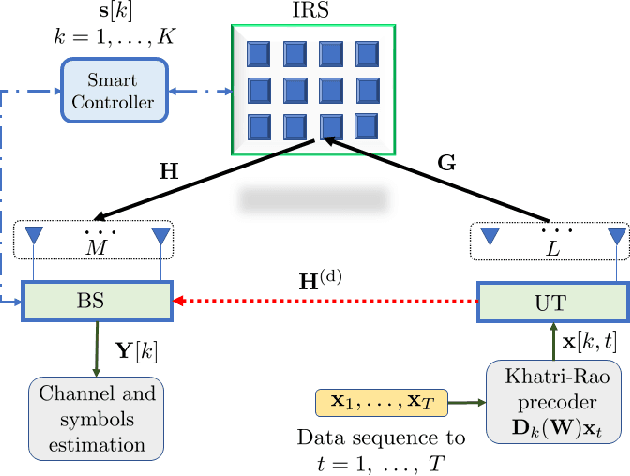Gilderlan Tavares de Araújo
Reducing Complexity of Data-Aided Channel Estimation in RIS-Assisted Communications
Feb 28, 2025Abstract:We consider the data-aided channel estimation (CE) problem in a reconfigurable intelligent surface (RIS)-assisted wireless communication system, where the channel and information symbols are estimated jointly during the CE phase, differently from pure pilot-aided methods. We propose a two-stage semi-blind receiver that jointly estimates the combined channel and the data symbols, followed by channel decoupling. To this end, we derive a new modeling framework whose first stage recasts the received signal to allow for the joint estimation of the combined channel and transmitted symbols. In the second stage, channel decoupling is easily achieved via Khatri-Rao factorization, yielding a refined channel estimate. Our solution yields accurate estimates of the cascaded channel at lower computational complexity. Simulation results reveal a similar performance of the proposed method to that of the competitor while providing a substantially reduced computational cost.
Semi-Blind Joint Channel and Symbol Estimation for IRS-Assisted MIMO Systems
May 20, 2022



Abstract:Intelligent reflecting surface (IRS) is a promising technology for the 6th generation of wireless systems, realizing the smart radio environment concept. In this paper, we present a novel tensor-based receiver for IRS-assisted multiple-input multiple-output communications capable of jointly estimating the channels and the transmitted data streams in a semi-blind fashion. Assuming a fully passive IRS architecture and introducing a simple space-time coding scheme at the transmitter, the received signal model can be advantageously built using the PARATUCK tensor model, which can be seen as a hybrid of parallel factor analysis and Tucker models. Exploiting the algebraic structure of the PARATUCK tensor model, a semi-blind receiver is derived. The proposed receiver is based on a trilinear alternating least squares method that iteratively estimates the two involved - IRS- base station and user terminal-IRS-communication channels and the transmitted symbol matrix. We discuss identifiability conditions that ensure the joint semi-blind recovery of the involved channel and symbol matrices, and propose a joint design of the coding and IRS reflection matrices to optimize the receiver performance. For the proposed semi-blind receiver, the derivation of the expected Cram\'er-Rao lower bound is also provided. A numerical performance evaluation of the proposed receiver design corroborates its superior performance in terms of the normalized mean squared error of the estimated channels and the achieved symbol error rate.
Semi-Blind Joint Channel and Symbol Estimation in IRS-Assisted Multi-User MIMO Networks
Feb 22, 2022

Abstract:Intelligent reflecting surface (IRS) is a promising technology for beyond 5G wireless communications. In fully passive IRS-assisted systems, channel estimation is challenging and should be carried out only at the base station or at the terminals since the elements of the IRS are incapable of processing signals. In this letter, we formulate a tensor-based semi-blind receiver that solves the joint channel and symbol estimation problem in an IRS-assisted multi-user multiple-input multiple-output system. The proposed approach relies on a generalized PARATUCK tensor model of the signals reflected by the IRS, based on a two-stage closed-form semi-blind receiver using Khatri-Rao and Kronecker factorizations. Simulation results demonstrate the superior performance of the proposed semi-blind receiver, in terms of the normalized mean squared error and symbol error rate, as well as a lower computational complexity, compared to recently proposed parallel factor analysis-based receivers.
 Add to Chrome
Add to Chrome Add to Firefox
Add to Firefox Add to Edge
Add to Edge